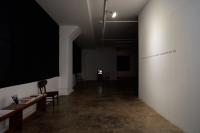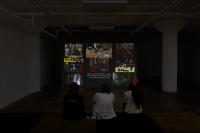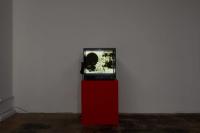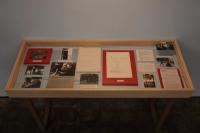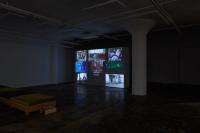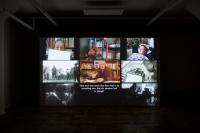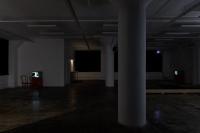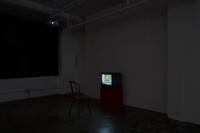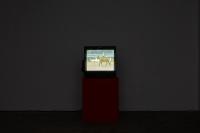François Pain, Psychiatry is what Psychiatrists do
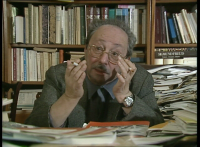
François Pain’s François Tosquelles, une politique de la folie (1988), video still. Written by François Pain, Jean-Claude Polack and Danièlle Sivadon. Image courtesy of the artist and New Galerie.
François Pain, Psychiatry is what Psychiatrists do
Part of
Programs
Opening: Friday, February 21, 6-9pm
Psychiatry is what Psychiatrists do marks French artist François Pain’s first solo institutional exhibition in the United States. This focused survey presents new work paired with Pain’s experimental works from the 1980s, accompanied by a publication from Semiotext(e) and additional programming in collaboration with 2220 Arts +Archives and Apogee Graphics. The project is organized by guest curator and researcher Perwana Nazif.
Institutional Psychotherapy as one of the Fine Arts… (2025) is a new video installation composed of nine screens, each subject to a zealous vacillation of archival footage of waged wars, daily life at experimental hospitals Saint-Alban and La Borde in France, vignettes of Pain’s experimental films, filmed protests, and intimate discussions with celebrated psychoanalysts and psychiatrists of Institutional Psychotherapy Francesc Tosquelles, Jean Oury, and Félix Guattari.
Pain worked at the clinic of La Borde, one of the more famous translations of Saint-Alban hospital’s Institutional Psychotherapy (IP), from 1965 to 1972. A cultural revolution and antifascist resistance movement that aimed to cure the institution of the hospital itself in order to render treatment possible, IP was a horizontal, collective effort traversing political, libidinal, and subjective economies. It emerged in Saint-Alban during WWII, as the German occupation and the Vichy government’s ‘soft extermination’ policies produced a fatal dearth of adequate clinical care and sustenance. At Saint-Alban, patients and non-clinical staff alike took responsibility in opening the hospital to make possible a collective directed towards care, where the “mad” and “normal” lived together, where resistance fighters, artist-poet refugees, dissidents of the state hid with patients. Psychiatry is what psychiatrists do, but psychiatrists stand outside neither the social, historical and material world, nor what the patient suffers.
At La Borde, Pain met and established significant relationships with the major representatives of IP (all of whom spent time at Saint-Alban): exiled Catalan militant and IP founding figure Francesc Tosquelles (who became Pain’s analyst), La Borde’s founder Jean Oury, and Pain’s close friend and core staff member of La Borde, Félix Guattari. Pain and Guattari’s close friendship and collaborations would lead to several decentralized, collective efforts towards alternative media (such as pirate radio) and bringing together left-wing militants, artists, and scholars together. The triangulation of these three thinker-practitioners, “TOG”, offered a conceptual and practical foundation for Pain. Each point of the triangulation, as figure, method, and thought, is distinctively and collectively expressed in Pain’s transmission of political, social, and clinical transformations.
The structure of Institutional Psychotherapy as… marks and eclipses historical and aesthetic reference points at risk of radical collapse. The installation presents scenes held precariously together: presumed patients exercising their “right to wander” in and around the hospital, and people in ergotherapy sessions before, following, and alongside images of varying wars and battled fronts. Figures move through the frames of the hospital, but the distinction between patients and non-patients is not obvious. An artist holds his paper car sculptures to the camera while, below this image, staff and patients tear down the walls of Saint-Alban. Here is an enigma of structure itself, of the collective assemblage (of enunciation), and of “madness”. Catastrophe and madness remain questions of suspended disaster, simultaneous loss and the forthcoming, surpassing existence of a world. This is not unrelated to the suffering of experience, the sometimes unbearable agony of inhabiting a world. The social persists, subjectivity persists, and there exists a constant and creative effort of reconstruction within and across film, “madness” and sites of psychiatric care. The space between the nine disparate screens is one of suspension and threshold. It disarticulates a coherent figure of transmitter and receiver, doctor and patient, filmmaker and filmed, and unfastens the striae that places the exegetic on one side and the diegetic on the other.
Across the room plays The Crystal Wave (1985). Based on a story by the reclusive writer and pedagogue Fernand Deligny on the imminent arrival of an engulfing crystal wave, the film was a collective production from Pain’s film workshop at La Borde for an annual gathering of hospital clubs. Nearby, The Green Notebook (1980), written by Guattari, meanders through a paranoid monologue, a lost green notebook, succeeding breakdowns of a break-up among fantasy, subjectivity, and “reality”. Pain’s films are not an aestheticization of madness nor politics, but an approach to image as that of encounter. They are image as event, image as difference. The same images repeat in Pain’s practice–The Crystal Wave ripples in the central installation of the exhibition, for example–constructed and reconstructed in distinct forms and chance relations. Sometimes, the same image is named differently. Other times, different images are under the same name. Pain’s work is a social cinema, a transversal cinema, a post-media-poetics of heterogeneity endlessly undertaking a rearrangement against social and psychic alienation, against established orders. There is a collective attempt, a treatment, if not a cure, of image. A network precedes, proceeds and follows the existential image. It is an image that begins with “Intifada Everywhere!”
***
This exhibition is part of JOAN’s second Chapter of programming, which runs from April 2024 through July 2025, and brings together artists and collectives that explore varying communal structures of intervention and support, as experiments towards liberatory futures.
François Pain, Psychiatry is what Psychiatrists do, is accompanied by a booklet published by Semiotext(e) including materials from Pain’s archive and contributions from Franco “Bifo” Berardi, John Kelsey, Stefania Pandolfo, AbdouMaliq Simone, Jackie Wang, and Hannah Zeavin.
Upcoming Programming:
On February 26th at 8pm, An evening with François Pain: Experiments in film and psychiatric clinics at 2220 Arts + Archives presents François Pain’s most celebrated works around the hospital. The selection of short films will be followed by a conversation between the filmmaker, coeditor of Semiotext(e) and writer Hedi El Kholti, and guest curator Perwana Nazif. More information on the program and tickets here.
On March 13th at 7pm, Apogee Graphics/LA Prime presents a lecture by Hannah Zeavin expanding on her “Liberated Frequencies” essay in the Semiotext(e) publication. The event will be held at the Westin Bonaventure, Suite 518 (Yellow Tower). For more details, please email info@apogeegraphics.la.
François Pain (b. 1945) is a filmmaker based in Paris. He is considered a seminal figure in alternative media and psychiatric networks. A founding member of the French post-’68 Free Radio Movement, Pain was an early practitioner of video art in the changing landscape of 1970s handheld video technologies, and a leading film chronicler of experimental clinics of institutional psychotherapy.
In 1965 Pain embarked on a residency at La Borde psychiatric clinic. There, he met philosopher and psychoanalyst Félix Guattari, La Borde founder Jean Oury, writer and experimental educator Fernand Deligny, and founding figure of institutional psychotherapy Francesc Tosquelles. Pain would establish lasting friendships and collaborations with these major names in radical psychiatry.
Pain’s videos have been released over the years through French TV and featured in various international film festivals including Cannes, Berlinale, and the Graz Festival in Austria. His work has been exhibited or screened at the São Paulo Biennial, Reina Sofia Museum in Madrid, Centre d’Art Contemporain Genève, and the Palais de Tokyo, Centre Pompidou, and Jeu de Paume in Paris, among others. He has led several media workshops in psychiatric and rehabilitative institutions.
Perwana Nazif is a writer and programmer. She is the Art Director for the Los Angeles Review of Books and a contributing editor at Parapraxis.
Installation by Nathan Manthey
Creative and installation support from Matt Paweski, Claudette Gacuti and Roula Nassar
Special thanks to Nick Nauman, Matt Paweski, Maj, Marion Scemama, Corentin Hamel, Hedi El Kholti, and Sandra Alvarez de Toledo.
This project is supported, in part, by Arthur & Elisabeth Forney and Villa Albertine.

